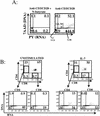Interleukin-7 induces expression of latent human immunodeficiency virus type 1 with minimal effects on T-cell phenotype
- PMID: 12438635
- PMCID: PMC136703
- DOI: 10.1128/jvi.76.24.13077-13082.2002
Interleukin-7 induces expression of latent human immunodeficiency virus type 1 with minimal effects on T-cell phenotype
Abstract
Latent human immunodeficiency virus type 1 (HIV-1) persists even in patients treated with antiretroviral therapy. New treatment strategies are therefore needed to eradicate this latent viral reservoir without reducing immune cell function. We characterize the interleukin-7 (IL-7)-induced stimulation of primary human T cells and thymocytes and demonstrate, using the SCID-hu model, that IL-7 induces substantial expression of latent HIV while having minimal effects on the cell phenotype. Thus, IL-7 is a viable candidate to activate expression of latent HIV and may facilitate immune clearance of latently infected cells.
Figures




References
-
- Aldrovandi, G. M., G. Feuer, L. Gao, B. Jamieson, M. Kristeva, I. S. Chen, and J. A. Zack. 1993. The SCID-hu mouse as a model for HIV-1 infection. Nature 363:732-736. - PubMed
-
- Amos, C. L., A. Woetmann, M. Nielsen, C. Geisler, N. Odum, B. L. Brown, and P. R. Dobson. 1998. The role of caspase 3 and BclxL in the action of interleukin 7 (IL-7): a survival factor in activated human T cells. Cytokine 10:662-668. - PubMed
-
- Anderson, G., and E. J. Jenkinson. 1995. The role of the thymus during T-lymphocyte development in vitro. Semin. Immunol. 7:177-183. - PubMed
-
- Bonyhadi, M. L., L. Rabin, S. Salimi, D. A. Brown, J. Kosek, J. M. McCune, and H. Kaneshima. 1993. HIV induces thymus depletion in vivo. Nature 363:728-732. - PubMed
Publication types
MeSH terms
Substances
Grants and funding
LinkOut - more resources
Full Text Sources
Other Literature Sources

